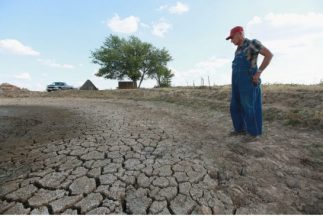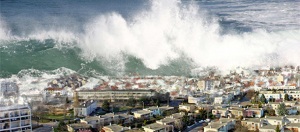After politicians and other talking heads who have denied Climate Change finally admit that there might be a problem, their response, typically, is “we can’t afford to make changes.” I could not disagree more. On the contrary, we can’t afford NOT to make changes.
While we can’t point our fingers and say with certainty which natural disasters are caused by climate change, there have been more of them than previously occurred and many of them have been much worse than in the past. Not only have countless numbers of people lost their homes, their communities, and their lives, but the financial losses have become staggering.
Here is a list of the top ten costliest natural disasters in the United States:

Hurricane Katrina on the Gulf Coast and especially New Orleans in 2005
Damage: $145,000,000,000 (that’s $145 billion, but I think it is helpful to see all those zeros)
Deaths: 1,833
Drought & Heat Wave in the Midwest and Southeast in 1988
Damage: $76,400,000,000
Deaths: 5,000-10,000
Northridge Earthquake in Southern California in 1994
Damage: $67,000,000,000
Deaths: 60
Hurricane Sandy along the Eastern Coast, but especially in New York and New Jersey in 2012
Damage: $65,000,000,000 (does not include the Caribbean and Canada)
Deaths: 156
Drought & Heat Wave in the Midwest and Southern Plain States in 1980
Damage: $54,800,000,000
Deaths: 10,000
Hurricane Andrew in Florida and Louisiana in 1992
Damage: $43,500,000,000
Deaths: 61
Midwest Floods along the Missouri and Mississippi Rivers in 1993
Damage: $32,800,000,000
Deaths: 48

Drought & Heat Wave starting in the West and progressing across the U.S. to the East Coast in 2012
Damage: $30,300,000,000
Deaths: 123
Hurricane Ike 2008 mostly in Texas and Louisiana, but also inland
Damage: $28,400,000,000
Deaths: 112
Hurricane Rita & Wilma in Florida, Louisiana, and Texas in 2005
Damage: $18,600,000,000
Deaths: 35
Where did I get these numbers? Why from an insurance company of course (and The Christian Science Monitor—a pretty conservative publication). If you live in a place that is prone to hurricanes your insurance will be higher than if you don’t. If they happen more often, you will pay higher premiums. Insurance companies are very pragmatic. They are not political or partisan. They just want to make money and the greater the risk you present, the more you must pay. Other organizations that take climate change seriously include the Pentagon and the CIA (when people’s lives and homes are threatened, they tend to get testy) and Pension Funds (again, it’s about money).
If the above numbers seem modest to you (which I take to mean your earnings do not place you in the top one tenth of the 1%), consider that the list only includes disasters in the United States. Here are the other, recent, “big ones” that have occurred world-wide.

Japanese Earthquake and Tsunami, 2011
Damage: $210,000,000,000
Deaths: 15,840
Sichuan Earthquake 2008
Damage: $148,000,000,000
Deaths: 69,197
Thailand Floods 2011
Damage: $45,700,000,000
Deaths: 815
Yangtze River Flood 1998
Damage: $26,000,000,000
Deaths: 4,159
Indian Ocean Earthquake & Tsunami 2004
Damage: $15,000,000,000
Deaths: 227,898
Some might dismiss earthquakes as not caused by climate change, but scientists are increasingly finding a link between the two. It seems that if we can send a man to the moon, we can affect plate tectonics. I am not sure if I am more amazed by our hubris or by the scope by which we are changing our planet.
And do I need to say it again—it’s expensive.
Changes are happening, literally, right before our eyes. If I wasn’t so terrified of the future, I could become sucked into the theatre of it all (catastrophes caught on film that look like Hollywood-generated movies, politicians denying that it is happening). If the stakes weren’t so high, it could be pretty entertaining.
Like most people, I have a hard time keeping my focus on the crisis we are headed towards. I get pretty exorcised about other things going on. And they are pretty noteworthy, but, as a mother, most of it doesn’t matter if my child is going to be living in a world more akin to the one portrayed in the Mad Max movie of 1979 than the one I grew up in. I am unsure what skills my son really needs to thrive and survive in the world he is inheriting. Should I emphasize computer science (sounds practical) or survival skills à la MacGyver (yay duct tape and Swiss Army knives!)
Recently, I began reading Naomi Klein’s book This Changes Everything. She takes climate change very seriously. Which is to say she understands Rome is burning and we’re all fiddling like our lives depended upon it. However, she does see a silver lining: this is an opportunity. If we actually want to survive what we have wrought in some semblance of what we have known (ie not tearing each other apart like mad dogs as everything falls apart), we have to change things from the ground up, and now! Therefore, we have an opportunity to make everything better. This means improving our democracy, our financial system, and reducing widespread inequalities. In effect, if we act decisively, we could not only pull ourselves back from the brink, but improve the quality of all our lives as well.
So, we have a choice. Pay through the nose for the collateral damage of climate change and suffer through the extreme weather or pay perhaps less and not have as much extreme weather. It seems pretty simple to me.
The news regarding climate change is pretty grim out there, so we have to take our inspiration where we can find it. I hope all of you will join me in fighting for something good—not just against something bad. I want something better than delivering my son from a nightmare, I want to give him a joyful, hopeful future.
